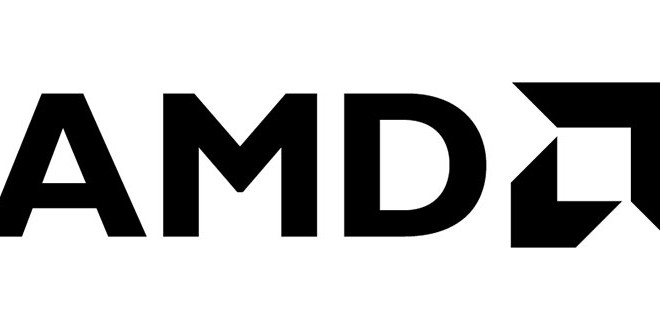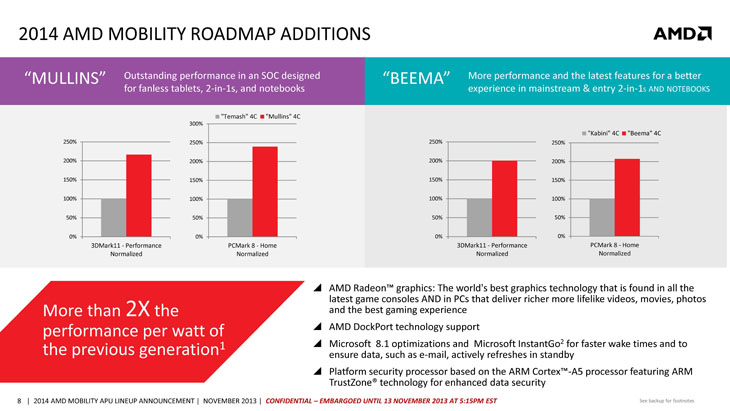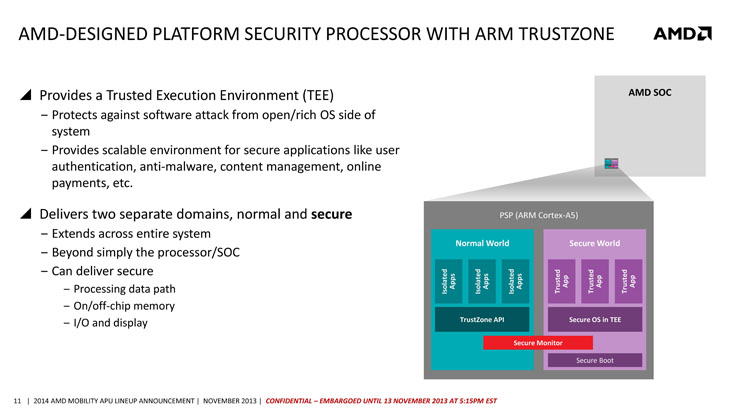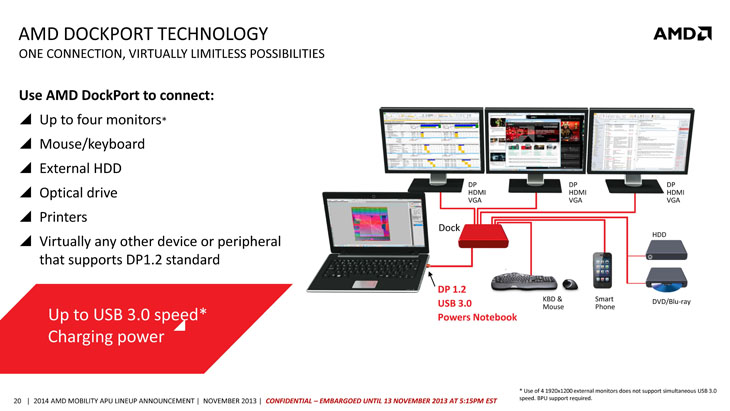AMD is releasing bits of information regarding to the upcoming products. First the company set the launch date for the upcoming Kaveri desktop APU on January 14, 2014. Now, we got more information regarding to the plan for the upcoming mobile products.
In 2014, AMD’s plan is essentially the same as 2013 where the company is focusing on the performance tablets, 2-in-1 systems, convertibles, and notebooks. AMD is planned to launch three APUs for the mobile products: “Kaveri”, “Beema” and “Mullins”. First,the Beema will replace the Kabini that is aimed for the low power and entry level notebooks. The Mullins will replace the Temash for the ultra-low power tablets, 2-1 system and fanless notebooks. The Kaveri will replace the Richland for the performance notebooks and ultrabooks. The main focus of these APUs will be lower power consumption and delivers a good performance per watt ratio.
While AMD is not ready to talk about the specifics on these APUs, we are expecting that they are based on similar architecture as the outgoing APUS as Beema and Mullins are evolutionary chip. These APUs will be based on “Puma” CPU core which is enhanced “Jaguar” core that was on the Kabini and Temash. The “Puma” core features performance improvement and better power management with support for deep sleep state. The focus on these APUs will be power. AMD states that we can expect up to twice of the performance per watt over the older APU with the 3DMark11 and PCMark 8 Home benchmarks. This is quite impressive considering the TDP envelope stayed the same and the fact that these APUs are still be based on the same 28nm node. The improvement in performance per watt ratio would be due to the combination of higher Turbo speed, maximum clockspeed, and better platform power management. Ultimately, we would have to wait for the retail product to verify the result.
Like the Kabini and Temash, the GPU core on the Beema and Mullins are based on the GCN architecture. Though, we believe they probably will get a slight clockspeed boost.
Both APUs will come in either 2 or 4 CPU core. It is worth noting that the TDP of the APU have been improved slightly. While the top end model Beema stayed the same 25W, the lowest end seemed to see a drop in TDP to 10W as oppose to 15W on the Kabini. The Mullin TDP also moved to about 2W compared to the 3~4W on the Temash. AMD has not set a release date but has stated that they will be available first half of 2014.
For the performance laptops and ultrabooks, we will see Kaveri based APU replacing the Richland. Like the desktop variant, the Kaveri APU wil feature the same technology such as hQ and hUMA. The GPU will also be GCN based with TrueAudio and Mantle support. As gaming will still be at AMD’s heart, the main focus for the Kaveri mobile APU would definitely be its graphic power where the move to the GCN would definitely be a welcoming change over the Richland. The APU will also be 2 or 4 cores and fit into 15 to 35 watt TDP. Compare to the Richland APUs, we can see the low end TDP also get a two watts drop. Kaveri will be manufactured with 28nm process (as oppose to 32nm on Richalnd) so we should expect to have a better thermal headroom here. It is unsure if AMD will use the headroom for higher performance or lower power consumption but most likely a combo of both. We do not yet have any performance comparison but we may get better idea once the deaktop Kaveri hits the market. Again, no official date has been set but expect it to arrive sometimes in the first half of 2014.
With the Beema and Mullins, AMD will implement Security Processor that based on the ARM Cortex A5 core as mentioned. The ARM Trust Zone technology for data security. It will provide protection against malware and viruses and a new way of user authentication for tasks such as payments and others.
The products will also support Microsoft InstantGo technology. It allows the system to wake up from standby mode under 500 milliseconds for the “instant” resume that we are so used to from our mobile devices. Also, systems are able to automatically refresh information such as email, chat, etc from the net as it maintains network connectivity even when the device sleeps.
Among the new features, the 2014 products will support AMD wireless display based on the Miracast technology for Windows 8.1. The products are also optimized for Windows 8.1 and Internet Explorer 11 with WebGL support.
They will also support AMD DockPort where with a single cable, you would be able to connect multiple devices such as display, USB devices, power source, etc. AMD will have more information at CES 2014.
 Bjorn3D.com Bjorn3d.com – Satisfying Your Daily Tech Cravings Since 1996
Bjorn3D.com Bjorn3d.com – Satisfying Your Daily Tech Cravings Since 1996












